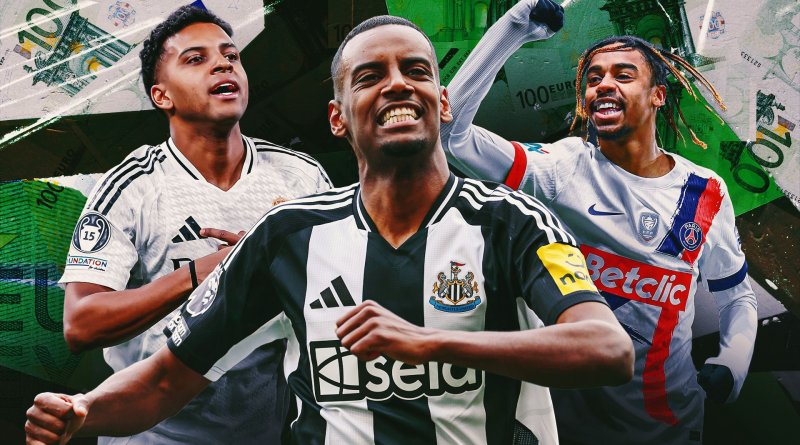€100m transfers: Stars tipped for 2025 mega moves
€100m transfers have become football’s new normal, and the 2025 market already promises another flurry of nine-figure deals as Europe’s elite chase marginal gains.
The Rise of €100m Transfers
When Neymar joined Paris Saint-Germain for €222m in 2017, the benchmark for €100m transfers was reset. Since then 17 players, most recently Florian Wirtz, have smashed through the once-unthinkable barrier. A combination of vast broadcasting revenues, ambitious ownership models and competition from emerging leagues such as Saudi Arabia has kept prices spiralling upward.
Contenders for the Next €100m Transfers
Alexander Isak – Newcastle United
Newcastle’s record signing has blended Scandinavian cool with Premier League fire. Blessed with pace, dribbling and a ruthless finish, Isak hit 21 league goals despite injury interruptions. Eddie Howe will fight to keep him, yet a release clause north of €100m means England’s giants and Paris Saint-Germain are circling.
Rodrygo – Real Madrid
Overshadowed by Vinícius Júnior and Jude Bellingham, Rodrygo remains a clutch performer. He scored in both Champions League semi-final legs and has mastered multiple attacking roles. Madrid rarely sell stars in their prime, but any club bold enough to table a €100m transfers bid may test Florentino Pérez’s resolve.
Viktor Gyökeres – Sporting CP
Forty-three goal involvements in his debut Liga Portugal campaign turned heads. Gyökeres blends brute strength with deft link-play, making him ideal for teams that press from the front. Sporting inserted a €100m clause, fully aware that Premier League sides crave a complete No.9.
Benoît Badiashile – Chelsea
Injury slowed the Frenchman’s London start, but his mix of pace, aerial dominance and left-footed distribution is rare. With top clubs yearning for ball-playing centre-backs, Chelsea could double their €38m outlay if offers approach nine figures.
Benjamin Sesko – RB Leipzig
Leipzig are experts at flipping talent for major profit, and Sesko is next in line. The Slovenian striker’s blend of height, mobility and finishing evokes Haaland comparisons. Leipzig reportedly want at least €100m to part ways in 2025.
Bradley Barcola – Paris Saint-Germain
The French winger’s acceleration and one-v-one ability have earned praise from Luis Enrique. With Mbappé gone, Barcola’s usage will skyrocket, and PSG’s Qatari owners will demand a premium should foreign bidders emerge.
Hugo Ekitike – Eintracht Frankfurt
Ekitike sought game time in Germany and rediscovered his slick link-play and penalty-box poaching. Frankfurt have a track record of reselling forwards at colossal profit—see Jović and Haller—so don’t rule out another of their trademark €100m transfers.
Romeo Mora – Benfica
Few outside Portugal know the Uruguayan midfielder, but Benfica scouts rarely miss. Powerful box-to-box displays and an eye for goal have already attracted Manchester City. Benfica inserted a €120m clause to maintain leverage.
Tyler Dibling – Southampton
Dibling’s mesmeric dribbling for England U-19s drew early Bale comparisons. Southampton, famed for academy exports, could command an eye-watering sum if the teenager continues his rapid ascent in the Championship or Premier League.
Vangelis Pavlidis – AZ Alkmaar
Thirty goals in the Eredivisie propelled the Greek striker onto shortlists across Europe. Alkmaar’s progressive model mirrors that of fellow Dutch sellers Ajax and PSV—expect the bidding war to start around €60m and climb quickly.
Why Fees Keep Climbing
Broadcast deals in England, the United States and Asia pour billions into club coffers. Meanwhile, multi-club ownership groups like City Football Group can shift talents internally, inflating book values without immediate cash outlay. The salary cap-free environment of Europe also allows gross figures to balloon unchecked. In this ecosystem, €100m transfers not only feel normal—they are strategic assets that generate marketing buzz and global appeal.
Impact on Selling Clubs
The upside is obvious: a single nine-figure sale can fund stadium refurbishments, youth facilities and four new signings. Borussia Dortmund’s model, perfected with the sales of Sancho and Bellingham, shows how reinvestment can keep a club competitive while balancing books. Yet there is danger in overreliance on windfalls; missed Champions League qualification after a blockbuster sale can leave a destabilised squad and frustrated fans.
Financial Fair Play & Creative Accounting
UEFA’s updated regulations allow greater losses if owners inject equity, but amortisation rules tighten. Clubs now spread fees over contract lengths to soften yearly impacts—hence the seven- or eight-year deals seen at Chelsea. Critics argue this inflates a bubble that could burst if on-field success falls short. Supporters counter that the modern game’s global audience safeguards revenue growth and, by extension, the feasibility of €100m transfers.
The Premier League Factor
English clubs remain the primary accelerant. Even mid-table sides boast higher TV income than continental giants, enabling them to refuse lowball offers and pay above-market rates. When Newcastle or Aston Villa meet a release clause, rivals must respond or risk losing ground. The result: transfer records tumble annually.
Next Summer’s Market Movers
Euro 2024 and Copa América will act as showcases. A string of tournament goals can add tens of millions to a valuation overnight. Scouting departments monitor expected-goals data, progressive carries and off-ball metrics, yet public perception—and highlight-reel moments—still sway negotiations. Expect CEOs to reference advanced analytics in press conferences while ultimately bowing to supporter pressure for marquee names.
Conclusion & Opinion
Transfer inflation feels unstoppable, but history suggests cycles. A global recession, stricter regulations or the failure of a handful of headline moves could force recalibration. For now, the talent pipeline is rich, the money is flowing, and another batch of €100m transfers is all but inevitable.
Opinion: Football’s arms race thrills neutrals yet distances clubs from communities that built them. Governing bodies must balance ambition with sustainability, or the sport risks becoming a playground for the few rather than a passion for the many.
Your global gateway to nonstop football coverage:
Goal Sports News
Share this content:
